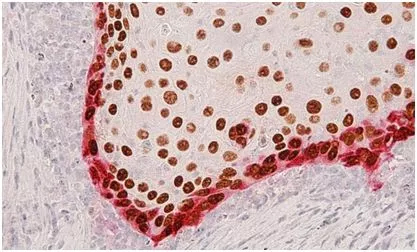Cell: Heavy! Building a complete cell map of human head and neck cancer for the first time
Release date: 2018-01-08
Head and neck tumors are more common in the United States and worldwide, and are the sixth leading cause of cancer-related diseases and death. Although this tumor is often found in the tongue, cheeks or throat, it allows surgical removal, but it can spread further through the lymph nodes. Unfortunately, once this cancer spreads in this way in a process called metastasis, it becomes more challenging to treat it, and patients often have poorer treatment outcomes.

Image courtesy of the Massachusetts Eye and Ear Infirmary.
According to a new study, head and neck tumors containing cells undergoing partial epithelial-to-mesenchymal transition (EMT) are more likely to invade and spread to other parts of the body. Researchers from Massachusetts General Hospital and Broad Research researchers have developed the first map of head and neck cancer in this new study, revealing many of the primary head and neck tumors and their metastases. Different types of cancer cells and non-cancer cells. EMT converts these cells from a neatly arranged block structure into an irregular structure that extends into the surrounding environment. These findings provide important clues about how head and neck cancer metastasizes and may have an impact on other common cancers. The results of the study were published in the December 14th, 2017 issue of Cell, entitled "Single-Cell Transcriptomic Analysis of Primary and Metastatic Tumor Ecosystems in Head and Neck Cancer."
Using a method called single-cell RNA sequencing, the researchers analyzed more than 600 cells from head and neck squamous cell carcinoma, the most common head and neck cancer. Through their analysis, they constructed a map of all the different cells present in head and neck cancer. They can also describe a unique structural transformation involving cancer cells and normal cells in their environment, which allows tumors to spread.
Dr. Bradley E. Bernstein, co-author of the paper and the Cancer Center of Massachusetts General Hospital, said, “This is the clearest picture of this structural shift in human tumors. Over the years, it has been known that cells can lose them and surrounding tissues. The connection between them has become more mobile, but there has been debate about when, how and where human cancer occurs."
Partial epithelial-mesenchymal transition (EMT) is a process that results in the ability of cells that are usually static to produce migration. These findings suggest that head and neck tumors temporarily "borrow" this process of normal embryonic development to invade nearby tissues and spread, and these findings may be applicable to similar cancers such as breast, prostate and lung cancer.
Dr. Sidharth V. Puram, Harvard Medical School, the first author of the paper, said, “Although we are excited to provide a rich and detailed description of each cell type in head and neck tumors, we quickly realized the unique Cancer cells are present in some patients, but not in other patients. We want to know if these cancer cells can explain why some tumors spread to the neck and below the neck, while other tumors do not spread."
Clinicians treating head and neck tumors have been facing the possibility of this tumor spreading in patients for many years, and surgeons are still unsure of how to find tumor metastases and how to determine whether lymph node tissue in the neck needs to be removed. Understanding this process has the potential to avoid unnecessary surgery and also helps in planning chemotherapy and radiation therapy.
These researchers predict that tumors that experience this shift in the future may affect the way clinically manage cancer patients. This knowledge will allow the surgeon to make decisions based on the biological characteristics of each patient rather than the size of the tumor, and predict the likelihood that the tumor will spread to other parts of the body.
"We may be able to predict more accurately which patients will have a worse prognosis than our current tumor staging system," said Dr. Derrick T. Lin of Harvard Medical School. "We predict which patients will have lymph node metastasis." Being able to better optimize our treatment strategy. This insight may also lead to the development of new therapies that target this process and prevent metastasis from the primary site, given that cancer metastasis is one of the most difficult to treat and cancer patients. One of the biggest reasons for not being able to survive, these discoveries have opened up a whole new field of research."
Reference material
Sidharth V. Puram, Itay Tirosh, Anuraag S. Parikh et al. Single-Cell Transcriptomic Analysis of Primary and Metastatic Tumor Ecosystems in Head and Neck Cancer. Cell, 14 December 2017, 171(7), 1611–1624, doi:10.1016 /j.cell.2017.10.044
Source: Bio Valley
The folding foot bath machine is a device that can be used to soak and massage feet. It's designed to be portable and easy to store, making it ideal for those who want to enjoy a foot soak and massage at home or on the go.
The machine usually consists of a basin or bathtub filled with water and an electric device that provides massage and vibrations. Some models may also feature heating or cooling to help soothe sore or tired feet.
The foldable design allows the foot bath machine to be easily stored in a closet or under the bed when not in use. Some models may also come with a carrying case or tote bag for added convenience.
Overall, the Foldable Foot Bath is a great way to relax and rejuvenate your feet after a long day. It can also help improve circulation and reduce pain and discomfort associated with conditions like plantar fasciitis or arthritis.
Collapsible Foot Bath Machine,Foot Bath Basin,Foot Spa Bath Basin,Water Foot Bath Machine
Huaian Mimir Electric Appliance Co., LTD , https://www.mmfootbath.com